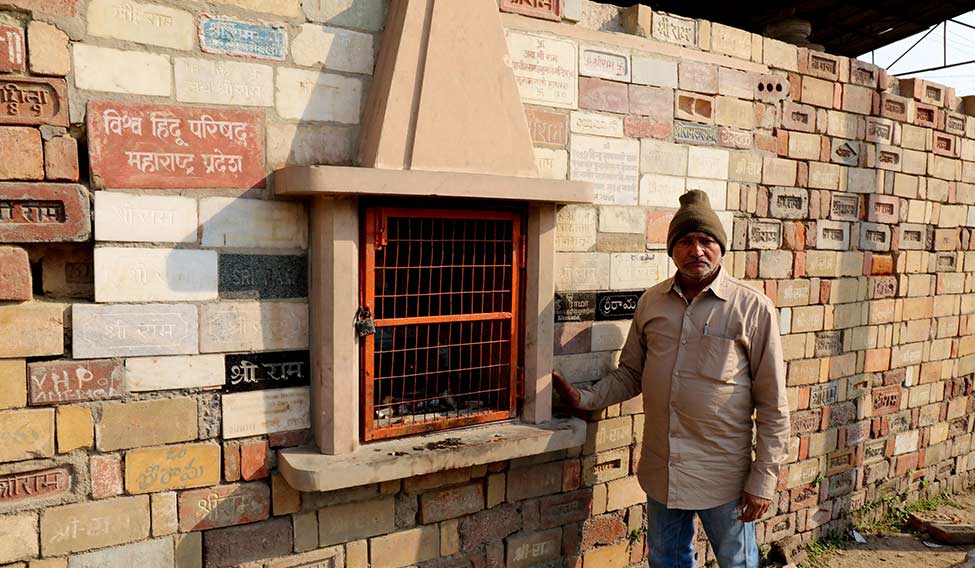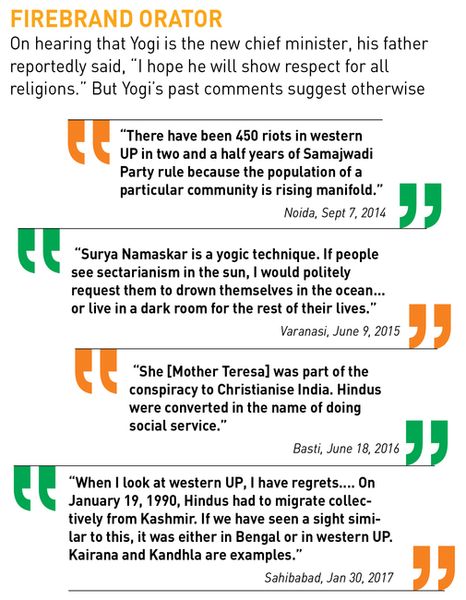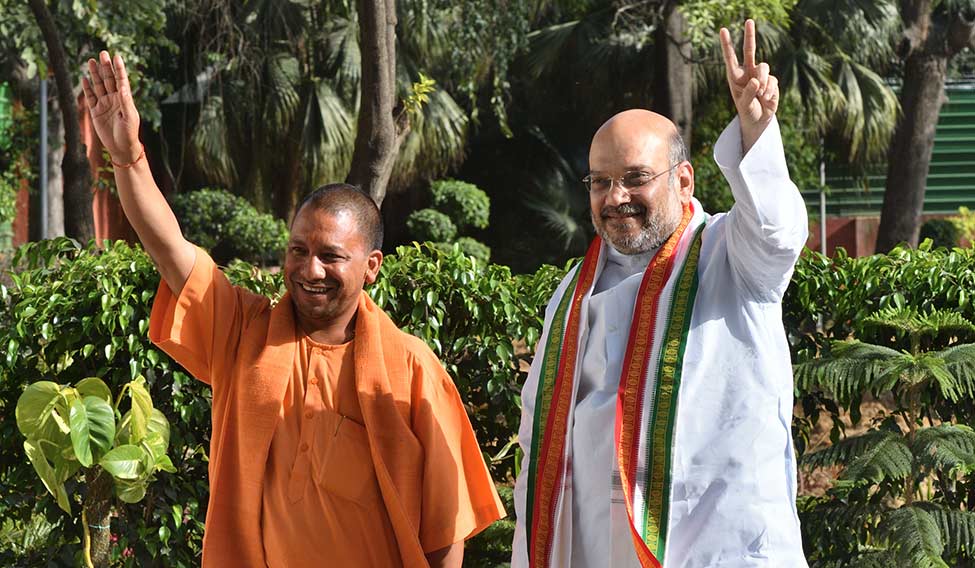Some people have already billed him as the “next Modi”. An ironclad disciplinarian, chronic bachelor, hindutva hardliner, fiery orator, mass magnet, strict vegetarian, yoga exponent... and now chief minister of Uttar Pradesh. Yogi Adityanath has arrived.
The five-time saffron-clad MP from Gorakhpur has little administrative experience, other than heading the Gorakhnath temple. Yet, the BJP chose him to lead Uttar Pradesh, clearly with eyes on the 2019 general elections.
Yogi, whose real name is Ajay Singh Bisht, was born in Uttarakhand on June 5, 1972. He has represented Gorakhpur since 1998, when he became the youngest member of the 12th Lok Sabha, at 26.
Like Modi, Adityanath’s day starts early. He wakes up at 3am and practises yoga before his morning rituals. He is a nature lover, who adores animals. His pets include a dog, a cat, deer and monkeys. His darling, however, is the dog, Kallu, with whom he spends his leisure breaks. The cow shelter near the temple has about 500 cows, and Adityanath has his breakfast only after feeding them and the fish in the pond on the temple premises.
Adityanath, described by some people as a “green saint”, is also credited with raising a green lung around the temple. He has planted and cared for numerous trees and medicinal plants in the area.

Known for simple living, Adityanath has frugal food such as rotis, boiled pulses and vegetables, papaya and butter milk. Every morning, he spends two hours sorting out problems of people in the region—a practice he has maintained for two decades.
The big question is which path Adityanath would take as chief minister—soft or hard? He has already tried to shake off the image of a divisive leader by singing Modi’s line of inclusive development—“Sabka saath, sabka vikas”—and promising to work without bias. The induction of a Muslim, Mohsin Raza, into his cabinet is also seen as sign of maturing and mellowing.
Political analysts say Adityanath has been rewarded for his hard work, especially in the recent assembly polls, in which he played a vital role in polarising votes.
However, in the process of galvanising the Hindu community, Adityanath often stirred up controversies and irked the BJP brass. But he always enjoyed the blessings of the RSS.
Adityanath first hogged the limelight when he led a mass conversion of 5,000 Christians to Hinduism in 2005. Two years later, he was jailed for breaking curfew and disrupting peace. His subsequent inflammatory speeches have received bouquets and brickbats in equal measure. More recently, he invited flak for comparing Bollywood star Shah Rukh Khan to Pakistani terrorist Hafiz Saeed.
 Brick by brick: A caretaker stands besides bricks meant for the construction of the Ram temple in Ayodhya | Pawan Kumar
Brick by brick: A caretaker stands besides bricks meant for the construction of the Ram temple in Ayodhya | Pawan Kumar
Now, however, the sangh parivar seems to have carefully crafted a gameplan based on inclusivity. Adityanath, an upper caste Thakur, has given ample representation to backward castes and dalits. Also, the inclusion of Raza in his cabinet has somewhat allayed the anxieties of the minority community, with many Islamic leaders hailing the move.
Why Raza? One, he is the son-in-law of BJP veteran and Manipur Governor Najma Heptulla. Two, he belongs to the Shia community, which is considered close to the BJP.
For the first time in history, the state will have two deputy chief ministers—Dinesh Sharma, a Brhamin, and the BJP’s state president Keshav Prasad Maurya, an OBC.
Adityanath has picked 15 ministers from backward castes, 15 from upper castes, four dalits and the remaining from other sub-castes.
The BJP had fielded 48 turncoats, ignoring dissent from its cadre. Of these, 44 won, and Adityanath has accommodated nine of them, including former state Congress president Rita Bahuguna Joshi, in his ministry.
Adityanath has done his best to maintain regional balance, too—15 ministers from eastern UP, 16 from central UP and 14 from western UP, and 2 from the Bundelkhand region, which had been ignored by the previous government.
A big talking point was the absence of a minister from Ayodhya, even as MLAs from the holy abodes of Kashi and Mathura got cabinet berths.
That brings us to the hot issue of building a Ram temple in Ayodhya, a longtime promise of the BJP. It was one of the highlights of the BJP’s poll manifesto.

“We will fulfil all promises made in our sanklap patra (manifesto), and will eradicate maladies such as corruption, crime and nepotism,” said Adityanath, avoiding the Ram temple issue.
The clamour for the temple has gone up, especially with the Supreme Court suggesting that the dispute be settled outside court. Senior RSS ideologue M.G. Vaidya claimed that Uttar Pradesh has given the BJP a massive mandate to build the Ram temple.
During the election campaign, though Modi avoided the issue, many BJP leaders had reiterated their promise of building a Ram temple in Ayodhya. With power in Uttar Pradesh and stronger clout in the Rajya Sabha, the BJP will have to bite the holy bullet.
“The formation of the BJP government in Uttar Pradesh, following the victory at the Centre in 2014, means that the atmosphere is conducive to building the temple,” says Mahant Suresh Das, a member of the Ram Janmabhoomi Nyas, a trust formed to oversee the temple’s construction. “The BJP got such a huge majority because it had mentioned the temple in its manifesto.”
Former MP Ram Vilas Vedanti, who has been associated with the temple movement, says: “When the BJP formed government at the Centre, people wondered when the temple’s construction would begin. Now, the BJP has wrested power in Uttar Pradesh, too. We hope the prime minister would find some way to build the temple.”
On the economic front, a huge challenge for Adityanath will be keeping the mega promise of waiving agricultural loans. “Let us see if the BJP government waives farmers’ loans in its first cabinet meeting,” challenged outgoing chief minister Akhilesh Yadav.
The state has 2.33 crore farmers, of whom 92 per cent are small and marginal farmers. And the quantum of agricultural loans is Rs 1,26,889 crore.
Another priority for Adityanath would be ensuring “na goonda raj, na bhrastachar (no mafia rule, no corruption)”, a promise he reiterated in his farewell speech in Parliament, too. Cleansing the embedded muck in the system and reining in about 50 mafias that rule the underworld would be a quite a challenge.
Adityanath will also have to keep fringe groups within the sangh parivar, such as the Bajrang Dal, on a tight leash to ensure communal harmony.
If he crosses all these hurdles and proves his mettle, Adityanath could well indeed emerge as the “next Modi”.







